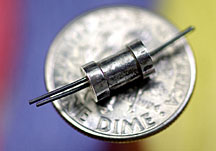Research
Highlights...
|
 |
| Number 161 |
June 28, 2004 |
Scientists explore origins of matter
|
Researchers are using the CEBAF Large Acceptance Spectrometer to study the physics of the early universe. |
In the first second after the Big Bang, the fundamental particles of matter had already begun coalescing into larger ones. For instance, quarks and gluons were wrapped up in protons and neutrons, the building blocks of the atomic nucleus. Jefferson Lab scientists are studying this process, called hadronization, by measuring what happens when they try to knock a single quark out of a proton or neutron. Since no quark is ever found alone, new quarks and gluons pop into existence to form multi-quark particles. Studying exactly how this happens may give researchers a better understanding of the early universe. [Kandice Carter, 757/269-7263,
kcarter@jlab.org]
|
|
Why calcium doping increases superconductivity
Scientists at DOE's Brookhaven Lab have learned why adding a small amount of calcium to a common high-temperature superconductor significantly increases the material's superconductivity. Using a transmission electron microscope, they found that calcium shrinks regions where the atoms that make up individual crystalline grains are misaligned at grain boundaries—the interfaces between adjacent grains. Shrinking these misaligned regions increases the flow of current across the boundary by 35 percent. By understanding this behavior, scientists may be able to engineer grain boundaries with improved properties, which may lead to the commercialization of high-temperature superconducting materials that could revolutionize our daily lives in the near future.
[Karen McNulty Walsh, 631/344-8350;
kmcnulty@bnl.gov]
|
|
Materials research: Can't be too thin
Researchers from Argonne National Laboratory and Northern Illinois University have shown that very thin materials can still retain an electric polarization, opening the potential for a wide range of tiny devices. The researchers found that the ferroelectric phase—the ability to hold a switchable electric polarization— is stable for thicknesses as small as 1.2 nanometers, one-billionth of a meter. These results, using the powerful X-rays at DOE's Advanced Photon Source, suggest that small thicknesses do not pose a problem to building tiny devices based on these materials. An increasingly wide range of applications are based on ferroelectric thin films, including sensors, microelectromechanical systems and memory systems.
[Catherine Foster, 630/252-5580;
cfoster@anl.gov]
|
|
Carbon-doped superconductors
Physicists at DOE's Ames Laboratory have enhanced the properties of magnesium diboride, MgB2, superconductors by doping them with carbon atoms. Experiments done by the researchers show that a 5 percent substitution of boron with carbon more than doubles the magnetic field that MgB2 can withstand and still remain superconducting, raising it from 16 Tesla for the pure material to 36 Tesla with the 5 percent carbon-doping. Although carbon-doping of MgB2 lowers its critical temperature to 35 K, 4 K less than in the pure material, the magnetic field as a function of temperature exceeds any of the more conventional niobium-tin superconductors.l
[Saren Johnston, 515/294-3474;
sarenj@ameslab.gov]
|
|
|
|
Idaho engineer revels in
hands-on research
Kevan Weaver of DOE's Idaho National Engineering and Environmental Laboratory has played the drums since he was ten years old. He also did a lot of physical farm work as a teenager. Building on these early interests and experiences, he was ultimately drawn to the engineering field, “I wanted to be hands-on, application oriented,” he says explaining his career choice.
Weaver, now serving as the INEEL's lead on the Gas-Cooled Fast Reactor for the Generation IV project, is the youngest member and co-chair of a Generation IV international steering committee. His hands are animated and his voice excited as he talks of each research element advancing the search for enhanced safety, the best fuels and the best design. “I love it when a plan comes together,” he says.
Throughout Weaver's progression into the nuclear field, he said, “Things just kept falling into place.” After finishing his undergraduate work in physics, Weaver considered the medical field, aerospace and robotics. He was surprised when someone suggested the idea of entering nuclear engineering. “I went into Physics because I liked it and Physics fit perfectly into nuclear engineering.” As far as the hands-on work that Weaver wanted, he found that in being a senior reactor operator and an assistant reactor supervisor at the University of Utah .
Weaver keeps busy now not only coordinating an international effort on the Generation IV project, but since Weaver speaks Spanish, he has been invited for the third year to address the Mexican Nuclear Society. This year, Weaver will do both a technical and an overview presentation.
The two challenges Weaver and his group face with the Gas-cooled Fast Reactor involve the safety system and high temperature fuels. But Weaver says they are getting very good results in resolving the difficulties. He adds he's also had no difficulty finding an outlet for his lifelong passion for the drums—by playing, when time permits, with an area orchestra.
Submitted by DOE's
Idaho National Engineering and Environmental Laboratory
|
|



